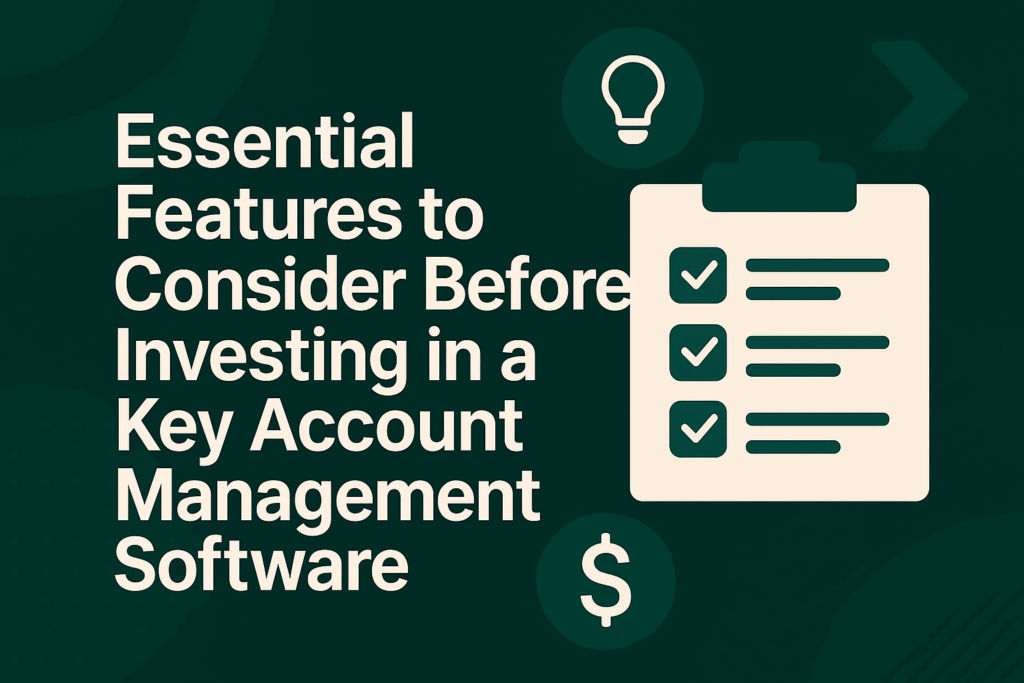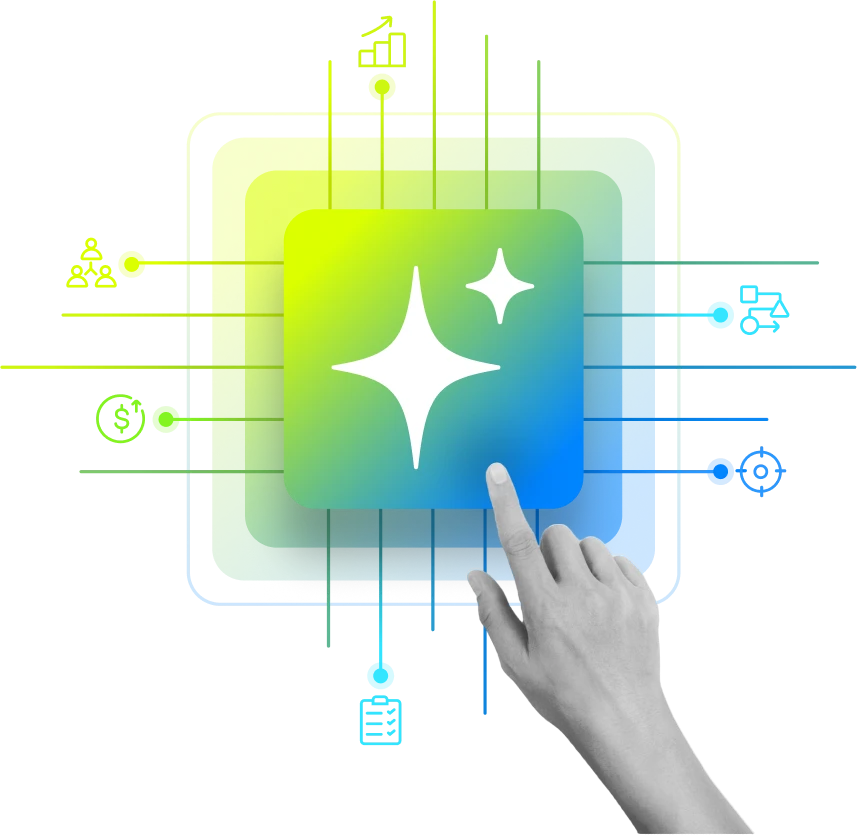71% of companies report seeing less than 26% improvement in revenue expansion since launching their strategic account management programs.
This statistic from Global Partners Training research reveals a brutal reality. Most organizations are failing at their most critical revenue strategy.
Despite investing in dedicated key account managers, specialized training, and strategic planning processes, the vast majority see minimal returns from their key account initiatives.
There is a clear gap and most AMs think it’s the tool and most leaders think it’s their talent. We think, it’s intelligence infrastructure. Here’s why.
Strategic accounts representing 20% of customers generate 80% of B2B revenue, yet most organizations manage them with tools designed for transactional sales rather than relationship orchestration across complex enterprise buying centers.
Whereas companies using purpose-built Key Account Management platforms report measurably different outcomes than those relying on traditional CRM systems.
The difference lies in having intelligence systems designed for enterprise relationship complexity, political dynamics, and multi-stakeholder decision processes.
The CRM Illusion: Why Your “Strategic” Account Management Isn’t Strategic
Walk into any enterprise sales floor and you’ll find account managers drowning in CRM data while starving for relationship intelligence.
The Great Activity Theater
CRM systems excel at one thing: making busy work look productive.
Your dashboard shows 47 logged calls this month. Twelve meetings scheduled. Email open rates tracked. Tasks completed on time.
Meanwhile, the economic buyer in procurement has been meeting with your competitor for six weeks. The technical champion who loved your solution got promoted to a different division. And the new VP brought his preferred vendor relationships from his previous company.
None of this shows up in your activity reports.
88% of executives agree that customer engagement significantly impacts their organization’s bottom line, according to Harvard Business Review research. But engagement isn’t about call volume—it’s about relationship depth across influence networks.
The Contact Card Fantasy
Traditional CRM treats enterprise relationships like a Rolodex with superpowers.
John Smith, VP Operations, ext. 4421, likes golf, two kids, graduated from State University. Last meeting: discussed Q3 implementation challenges.
What’s missing? John reports to Sarah, who can’t stand your company after a support incident two years ago. Sarah’s boss Michael is being pressured by the board to cut vendor costs by 15%. And Michael’s technical advisor Tom has a standing monthly lunch with your competitor’s regional director.
Enterprise buying happens through networks, not org charts. But CRM systems can’t map what they can’t see.
The Reactive Trap
CRM tells you what happened yesterday. Strategic account management requires predicting what happens tomorrow.
By the time your satisfaction surveys reveal problems, your competitor has been solving them for months. When contract renewal discussions turn contentious, the groundwork for replacement was laid during the previous fiscal year.
Elite account managers don’t just manage current relationships—they architect future ones.
Purpose-built Key Account Management software platforms provide four categories of intelligence that CRM systems can’t deliver. If you want to be a top 1% account manager, check out the checklist below.
Must-Have Features in Key Account Management Tools / Software To Consider Before Investing
Feature Category 1: Relationship Intelligence Architecture
Enterprise decisions happen through informal influence networks that rarely match organizational charts.
Influence Network Mapping
Real strategic account management starts with understanding who actually influences what.
The CFO might sign the contract, but the decision gets made in hallway conversations between people who trust each other’s judgment. The technical evaluation team provides recommendations, but the final choice reflects political calculations about departmental autonomy, vendor relationships, and career advancement.
Core features to evaluate:
□ Dynamic stakeholder visualization showing actual influence patterns, not just reporting structures
□ Champion identification algorithms that spot advocates based on behavior, not just stated preferences
□ Political climate tracking that monitors organizational pressures affecting procurement decisions
□ Relationship strength indicators across your entire team, revealing coverage gaps and single points of failure
□ Influence scoring that weighs stakeholder impact on purchase decisions versus formal authority levels
Competitive Intelligence Networks
Your competitor is not just selling features. They’re building relationships, identifying dissatisfied stakeholders, and positioning your weaknesses as their strengths.
Essential intelligence features:
□ Competitive relationship mapping showing which stakeholders maintain ongoing vendor discussions
□ Threat assessment algorithms that identify stakeholders most likely to champion alternatives
□ Displacement opportunity detection where competitor relationships show vulnerability
□ Win/loss correlation analysis revealing which relationship factors predict competitive outcomes
□ Defensive strategy recommendations based on competitive positioning and relationship gaps
Organizational Change Intelligence
Enterprise accounts exist in constant flux. Budget pressures, leadership transitions, strategic pivots, and market conditions create windows of opportunity and vulnerability.
Change monitoring capabilities:
□ Leadership transition tracking with succession impact analysis on vendor relationships
□ Budget cycle correlation predicting optimal timing for expansion conversations
□ Strategic initiative monitoring showing how internal projects affect procurement priorities
□ Risk factor identification highlighting organizational threats to account position
□ Opportunity timing optimization revealing when accounts become receptive to change
Feature Category 2: Growth Orchestration Systems
Expansion Intelligence Engines
Growth happens through systematic opportunity identification, not accidental discovery.
Every strategic account contains multiple expansion vectors: new departments, additional use cases, complementary solutions, geographical expansion, and competitive displacement opportunities.
Growth intelligence features:
□ Whitespace analysis mapping unexplored opportunities within existing account boundaries
□ Usage pattern analysis indicating readiness for additional solutions or capacity upgrades
□ Buying center expansion identification revealing new departments entering procurement processes
□ Customer maturity modeling predicting future needs based on growth trajectories and industry benchmarks
□ Cross-sell probability scoring combining relationship strength with product fit indicators
Revenue Orchestration Frameworks
Account growth requires coordinating multiple teams around shared objectives while maintaining consistent customer experience.
Orchestration capabilities:
□ Multi-team timeline coordination preventing conflicting customer interactions
□ Resource allocation optimization ensuring appropriate investment levels across account portfolio
□ Initiative prioritization based on revenue potential, probability, and competitive vulnerability
□ Success correlation analysis showing which activities drive measurable account expansion
□ ROI measurement frameworks demonstrating relationship investment returns
Feature Category 3: Institutional Memory Systems
Strategic relationships transcend individual account managers. They require organizational capabilities that survive personnel changes.
Knowledge Preservation Architecture
When account managers leave, relationship intelligence walks out the door with them.
Context about stakeholder personalities, political dynamics, competitive positioning, and strategic approaches gets lost. New account managers start from scratch, damaging continuity and creating vulnerability windows.
Preservation capabilities:
□ Relationship context documentation capturing interaction nuances beyond basic contact information
□ Decision rationale preservation explaining why specific strategies were chosen and how they performed
□ Stakeholder personality profiling helping new team members understand communication preferences and decision-making styles
□ Lessons learned systematization spreading successful approaches across similar account types
□ Transition workflow automation ensuring smooth handoffs without relationship disruption
Collaborative Intelligence Platforms
Strategic accounts require multiple specialists: technical experts, industry consultants, pricing analysts, legal advisors, and executive sponsors.
Collaboration features: □ Role-based information sharing ensuring appropriate access without overwhelming stakeholders
□ Cross-functional workflow management preventing duplicated efforts and conflicting messages
□ Expertise routing connecting account needs with internal specialists efficiently
□ Communication orchestration maintaining consistent messaging across all customer touchpoints
□ Success metric alignment ensuring all contributors work toward common account objectives
Feature Category 4: Predictive Performance Intelligence
Elite KAM platforms predict what’s likely to happen and recommend what should happen next.
Relationship Health Algorithms
Account health isn’t about satisfaction scores—it’s about relationship trajectory and competitive vulnerability.
Predictive health indicators:
□ Engagement pattern analysis detecting relationship strengthening or deterioration trends
□ Stakeholder coverage analysis identifying single points of failure in relationship networks
□ Competitive pressure assessment based on market dynamics and relationship intelligence
□ Renewal probability modeling combining contract timing with relationship health indicators
□ Advocacy potential scoring identifying accounts likely to provide references and referrals
Revenue Forecasting Intelligence
Strategic account revenue prediction requires understanding relationship quality, competitive positioning, and market dynamics—not just pipeline data.
Forecasting capabilities: □ Expansion probability modeling based on relationship strength and usage patterns
□ Churn risk prediction using engagement degradation and competitive intelligence
□ Opportunity timing optimization showing when accounts become receptive to expansion conversations
□ Market intelligence integration analyzing industry trends affecting specific account behavior
□ Scenario planning tools modeling different strategy approaches and their likely outcomes
But Why Most KAM Software Implementations Fail
Technology doesn’t create strategic account managers; it amplifies their capabilities.
The Tool vs. Strategy Confusion
Companies buy KAM platforms expecting them to automatically generate strategic insights and account growth.
The platform provides intelligence. Humans make strategic decisions based on that intelligence.
Without strategic thinking skills, relationship-building capabilities, and business acumen, even the best KAM platform becomes an expensive reporting system.
The Data Quality Problem
KAM platforms are intelligence systems. They require accurate, complete, and current data to generate valuable insights.
Garbage in, garbage out applies doubly to strategic account management. If relationship data is superficial, stakeholder information is outdated, and competitive intelligence is incomplete, the platform’s recommendations become misleading.
The Adoption Challenge
Strategic account management requires changing how teams think about customer relationships.
It’s not enough to train people on software features. You need to transform their approach from reactive relationship maintenance to proactive relationship orchestration.
This requires executive sponsorship, clear success metrics, and consistent reinforcement of new behaviors.
The Strategic Decision Point
Strategic accounts deserve strategic tools. Managing enterprise relationships with CRM platforms designed for transactional sales is like performing surgery with kitchen knives. You might survive the operation, but you’re handicapping your chances of success.
DemandFarm is the world’s first AI-powered, CRM-agnostic Key Account Management software designed specifically for account managers who refuse to settle for average results. Check out how top account managers are leveraging it.

